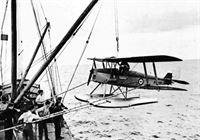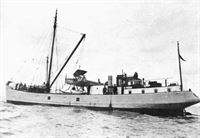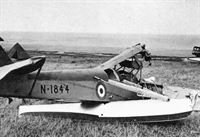
Варианты
- De Havilland - Tiger Moth / D.H.82 - 1931 - Великобритания
- De Havilland - Queen Bee / D.H.82B - 1935 - Великобритания
- Thruxton - Jackaroo - 1957 - Великобритания
Queen Bee / D.H.82B
de Havilland DH.82 Tiger Moth
<...>
Также необходимо упомянуть радиоуправляемый самолет-мишень DH.82B Queen Bee, представлявший собой упрощенную цельнодеревянную версию Tiger Moth. Он имел фюзеляж от Moth Major, крылья от Tiger Moth, мотор Gipsy Major, электрогенератор с приводом от крыльчатки и бензобак большой емкости. 5 января 1935 года прототип облетали с ручным управлением, затем собрали 380 машин для обучения пилотов-истребителей, зенитчиков и воздушных стрелков.
<...>
- Queen Bee / D.H.82B
Фотографии
-
Jane's All the World Aircraft 1938 / 03 - All the world's aeroplanes
Регистрационный номер: K4227 [2] The D.H. "Queen Bee" Wireless-controlled Target Aeroplane (130 h.p. D.H. "Gipsy-Major" engine).
-
Flight 1935-07 / Flight
Регистрационный номер: K5101 [2] MORE THAN MEETS THE EYE: This innocent-looking D.H. "Tiger Moth" is actually the wireless-controlled target machine, designated the "Queen Bee," the existence of which was kept an official "secret" until a few days ago. Note the connection at the side of the fuselage for catapult work.
-
Flight 1939-05 / Flight
Регистрационный номер: K5101 [2] -
Авиация и Время 2016-04 / А.Совенко - XXI век. В небе - роботы (2)
Регистрационный номер: K4227 [2] Беспилотный самолет-мишень DH.82B «Куин Би». Обе кабины на этом Queen Bee снабжены обтекателями. За двигателем виден ветроэлектрический генератор.
de Havilland D.H.82B Queen Bee. -
Мировая Авиация 48
Офицеры британских ВВС у пульта управления авиамишенью во время учебной тренировки с Queen Bee в военное время.
-
Flight 1939-08 / Flight
A notable photograph - necessarily rather hazy by reason of the high telescopic magnification - showing H.E. shells bursting near a Queen Bee operating from the range visited by the author.
-
Flight 1939-11 / Flight
The design of the De Havilland Queen Bee wireless-controlled target machine is based on that of the Tiger Moth trainer. The machine is of all-wooden construction; this improves the flotation qualities.
-
Aeroplane Monthly 1984-04 / Assisted take-off
A D.H.82B Queen Bee radio-controlled target aircraft has just been lowered onto its catapult. A total of 380 Queen Bees was produced by de Havilland at Hatfield and by Scottish Aviation at Glasgow. Queen Bees were equipped with Short twin metal floats, and pick-up slings were located in the wing centre section.
-
Flight 1940-10 / Flight
A De Havilland Queen Bee about to be catapulted into the air.
-
Flight 1939-08 / Flight
A Queen Bee on the catapult ready for launching.
-
Air Pictorial 1994-08 / G.Swanborough - British aircraft at war, 1939-1945 (8)
Регистрационный номер: L5894 Camouflaged Queen Bee L5894 is prepared for catapult launch - apparently at RAE Farnborough - in the presence of the Prime Minister, Winston Churchill.
-
Air-Britain Aeromilitaria 1981-03
Регистрационный номер: N1846 [3] Back in AM.1/76, before we were able to use photographs in Aeromilitaria, there was an article on RAF Weybourne, a Queen Bee launching and recovery base on the north coast of Norfolk to the west of Cromer. The four photographs show the activities of X Flight of No.1 AACU. They show N1846 on the catapult before launching...
-
Flight 1937-07 / Flight
Mechanisation: A De Havilland Queen Bee wireless-controlled target aeroplane is catapulted, pilotless, from H.M.S. Neptune.
-
Flight 1939-08 / Flight
With one wing down, but speedily to be corrected by the radio control, the Queen Bee leaves the catapult
-
Flight 1937-08 / Flight
GOOD HUNTING: Anti-aircraft gunners gave the lie to those who say that they will have only a moral effect on air raiders, when the 171st Battery, 61st A.A. Brigade R.A., Territorial Army, formerly known as the Finsbury Rifles, shot down a Queen Bee at their camp at Watchet, Somerset, on August 13. The Queen Bee, developed from the Tiger Moth, is a target aeroplane, controlled by wireless. They were intended for use by the Fleet, but this year they have been supplied for use by the Army too. As shown in these exclusive photographs, this one was catapulted into the air and she rose to 4,000 feet over the Bristol Channel. She was about a mile off when two A.A. guns opened fire, and the third volley hit her behind the engine. At first it was feared that she might crash on to the Battery, but she came down in the sea. The Gipsy Major engine broke loose and sank, but the fuselage and portions of the wings were salvaged.
-
Flight 1938-09 / Flight
Mr. HORE-BELISHA, the War Minister, visiting the Anti-Aircraft Practice Camp at Watchet, where he saw the 61st Anti-Aircraft (Territorial) Battery shooting at a Queen Bee.
-
Air-Britain Aeromilitaria 1981-03
Регистрационный номер: N1846 [3] Back in AM.1/76, before we were able to use photographs in Aeromilitaria, there was an article on RAF Weybourne, a Queen Bee launching and recovery base on the north coast of Norfolk to the west of Cromer. The four photographs show the activities of X Flight of No.1 AACU. They show N1846 being recovered from the sea off Norfolk after the flight...
-
Air-Britain Aeromilitaria 1981-03
Регистрационный номер: N1846 [3] Back in AM.1/76, before we were able to use photographs in Aeromilitaria, there was an article on RAF Weybourne, a Queen Bee launching and recovery base on the north coast of Norfolk to the west of Cromer. The four photographs show the activities of X Flight of No.1 AACU. They show N1846 snug aboard the recovery vessel. All were taken in June 1939.
-
Flight 1939-03 / Flight
The view illustrates the type of British wireless-controlled target aircraft - the De Havilland Queen Bee. The Queen Bee is being salvaged after a practice shoot by naval anti-aircraft guns. H.M.S. Argus, an obsolescent aircraft carrier, has been fitted out as a “mother ship” for these aircraft.
-
Air Pictorial 1958-07 / Photo Review
Регистрационный номер: VH-AIF FLOTATION CURIOSITIES. Maps out! In October 1957 Vern Reid flew his white and green de Havilland Queen Bee-conversion from Sandy Bay, Tasmania, to Maria Island in order to deliver an urgently-needed two-way radio for the islanders. Mr. Reid carried out the tandem-seat conversion (to Tiger Moth standard) at Sandy Bay. Note the ex-C.A.6 Wackett trainer canopy.
-
Air Pictorial 1958-10 / Scrapbook
Регистрационный номер: P4709 NAVY FASHION. In July "Photo Review" was published a photograph of a recent de Havilland Queen Bee conversion to Tiger Moth standard. That this is no new event is proved by the accompanying photograph of an ex-radio control gunnery target Royal Navy Queen Bee (P4709) which was converted to Tiger Moth dual-control standard at the R.N. Aircraft Repair Yard, Fay id, Canal Zone, in the summer of 1945. Painted bright royal blue with yellow serials it was used for communications and training by its "owner", Lt. (A) Peter W. Brooks, R.N.V.R., until February 1946.
-
Air Pictorial 1987-09 / A.Johnson - Register Review
Регистрационный номер: G-BLUZ, LF858 DH.82B Queen Bee G-BLUZ/'LF858', believed to be one of only three remaining examples, was another visitor to the Air-Britain Air Rally at Wroughton 27/6/87
-
Aeroplane Monthly 1986-07 / Grapevine
The de Havilland Queen Bee fuselage seen at the Mosquito Aircraft Museum on April 13 1986 will form the basis for a restoration project.
-
Aeroplane Monthly 1999-06 / J.Maynard - Spring-cleaning the hall /Mosquito aircraft museum/
The museum’s Paul Doyle standing by the D.H.82B Queen Bee whose restoration won for him the de Havilland Moth Club’s Arthur Cole Trophy in 1998.
-
Air-Britain Aeromilitaria 1981-03
Регистрационный номер: N1844 N1844 after it had spun into the sea off Weybourne on 27 June 1939. It was not repaired. N1846 has '118' on the cowling.
- Фотографии
























